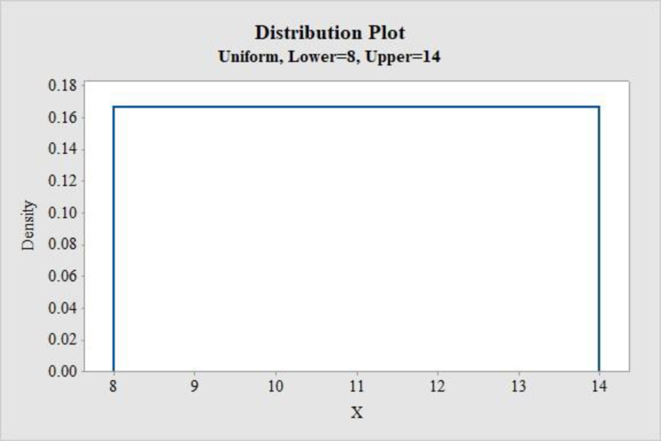
Concept explainers
Microwave ovens only last so long. The life-time of a microwave oven follows a uniform distribution between 8 and 14 years.
- (a) Draw this uniform distribution. What are the height and base values?
- (b) Show the total area under the curve is 1.00.
- (c) Calculate the
mean and the standard deviation of this distribution. - (d) What is the
probability a particular microwave oven lasts between 10 and 14 years? - (e) What is the probability a microwave oven will last less than 9 years?
a.
Draw the uniform distribution graphically.
Find the height and base values of distribution.
Answer to Problem 1SR
The height and base values of the distribution are 0.167 and 6, respectively.
Explanation of Solution
Step-by-step procedure to obtain the uniform distribution using MINITAB software:
- Choose Graph > Probability Distribution Plot.
- From Distribution, choose Uniform.
- Enter Lower endpoint as 8 and Upper endpoint as 14.
- Click Ok.
The output obtained using MINITAB software is represented as follows:

From the above output, the shape of the distribution is rectangle.
The height of the distribution is calculated below:
Therefore, the height of the distribution is 0.167.
The base of the distribution is obtained below:
The base value of the distribution is 6.
b.
Prove that the total area under the curve is 1.00
Explanation of Solution
Let X is the life-time of a microwave oven which follows uniform distribution over the interval from 8 and 14 years.
That is,
The probability density function of a uniform distribution is,
The height and base values of the distribution are 0.167 and 6 respectively.
The area under the curve is obtained below:
Therefore, the total area under the curve is 1.
c.
Compute the mean and standard deviation of the distribution.
Answer to Problem 1SR
The mean of the distribution is 11.
The standard deviation of the distribution is 1.73.
Explanation of Solution
The formula for mean of the distribution is stated below:
The mean life-time of a microwave oven is 11.
The formula for standard deviation of the distribution is computed below:
Therefore, the standard deviation of the distribution is 1.73.
d.
Find the probability that a particular microwave oven lasts between 10 and 14 years.
Answer to Problem 1SR
The probability that a particular microwave oven lasts between 10 and 14 years is 0.668.
Explanation of Solution
The height of the distribution is 0.167 and base of the distribution is 4 ( = 14 – 10).
The probability that a particular microwave oven lasts between 10 and 14 years is,
Therefore, the probability that a particular microwave oven lasts between 10 and 14 years is 0.668.
e.
Find the probability that a microwave oven will last less than 9 years.
Answer to Problem 1SR
The probability that a particular microwave oven will last less than 9 years is 0.167.
Explanation of Solution
The height of the distribution is 0.167 and base of the distribution is 1.
The probability that a particular microwave oven will last less than 9 years is calculated below:
Therefore, the probability that a particular microwave oven will last less than 9 years is 0.167.
Want to see more full solutions like this?
Chapter 7 Solutions
EBK STATISTICAL TECHNIQUES IN BUSINESS
- A company found that the daily sales revenue of its flagship product follows a normal distribution with a mean of $4500 and a standard deviation of $450. The company defines a "high-sales day" that is, any day with sales exceeding $4800. please provide a step by step on how to get the answers in excel Q: What percentage of days can the company expect to have "high-sales days" or sales greater than $4800? Q: What is the sales revenue threshold for the bottom 10% of days? (please note that 10% refers to the probability/area under bell curve towards the lower tail of bell curve) Provide answers in the yellow cellsarrow_forwardFind the critical value for a left-tailed test using the F distribution with a 0.025, degrees of freedom in the numerator=12, and degrees of freedom in the denominator = 50. A portion of the table of critical values of the F-distribution is provided. Click the icon to view the partial table of critical values of the F-distribution. What is the critical value? (Round to two decimal places as needed.)arrow_forwardA retail store manager claims that the average daily sales of the store are $1,500. You aim to test whether the actual average daily sales differ significantly from this claimed value. You can provide your answer by inserting a text box and the answer must include: Null hypothesis, Alternative hypothesis, Show answer (output table/summary table), and Conclusion based on the P value. Showing the calculation is a must. If calculation is missing,so please provide a step by step on the answers Numerical answers in the yellow cellsarrow_forward
 Glencoe Algebra 1, Student Edition, 9780079039897...AlgebraISBN:9780079039897Author:CarterPublisher:McGraw Hill
Glencoe Algebra 1, Student Edition, 9780079039897...AlgebraISBN:9780079039897Author:CarterPublisher:McGraw Hill Big Ideas Math A Bridge To Success Algebra 1: Stu...AlgebraISBN:9781680331141Author:HOUGHTON MIFFLIN HARCOURTPublisher:Houghton Mifflin Harcourt
Big Ideas Math A Bridge To Success Algebra 1: Stu...AlgebraISBN:9781680331141Author:HOUGHTON MIFFLIN HARCOURTPublisher:Houghton Mifflin Harcourt

